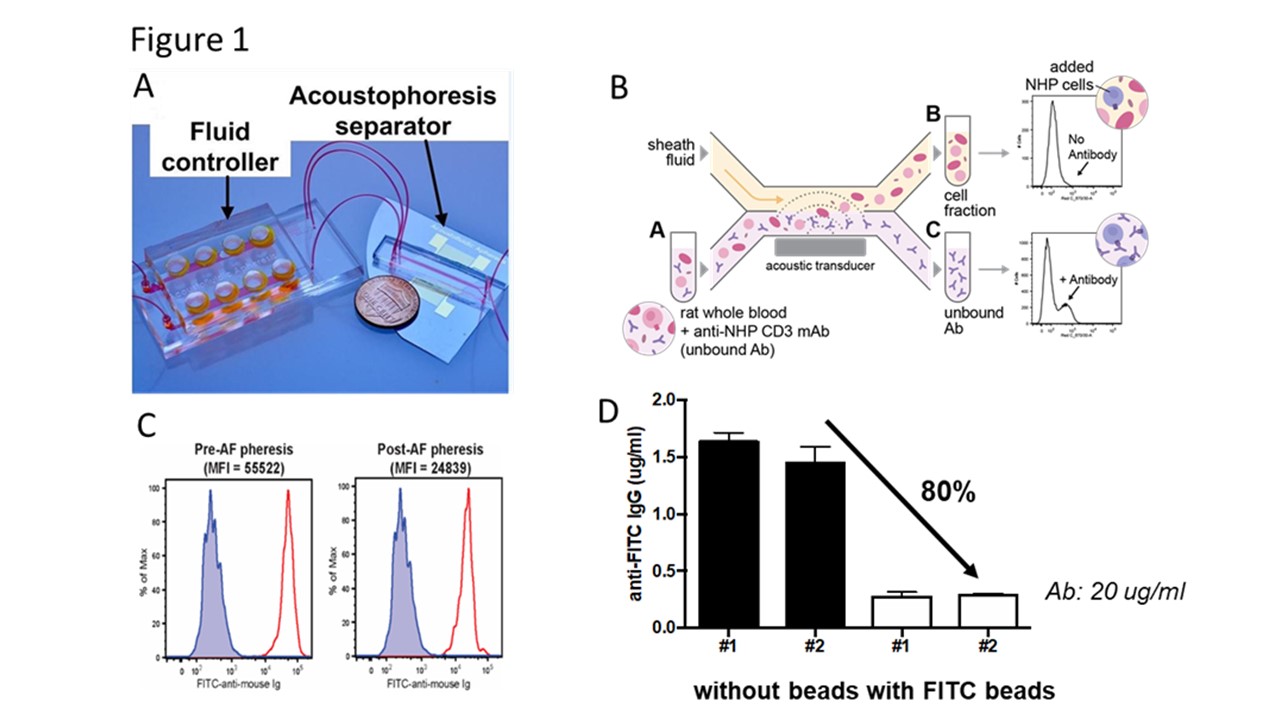Acoustofluidic Device to Remove Donor Specific Antibody in a Sensitized Animal Model
1Surgery, Duke University, Durham, NC, 2Pediatrics, Duke University, Durham, NC, 3Biomedical Engineering, Duke University, Durham, NC, 4Biostatistics and Bioinformatics, Duke University, Durham, NC, 5Internal Medicine, Duke University, Durham, NC
Meeting: 2021 American Transplant Congress
Abstract number: 211
Keywords: Alloantibodies, IgG, Sensitization
Session Information
Session Name: B cell/Antibody and Histocompatibility
Session Type: Rapid Fire Oral Abstract
Date: Monday, June 7, 2021
Session Time: 4:30pm-5:30pm
 Presentation Time: 4:40pm-4:45pm
Presentation Time: 4:40pm-4:45pm
Location: Virtual
*Purpose: Current therapies for antibody-mediated rejection are neither donor-specific nor are they tailored toward children, resulting in premature allograft loss and increased mortality. Apheresis involves a large machine for antibody removal that has been developed for adults, but its use in children is associated with hypotension, exposure to allergenic filters, and the need for blood transfusions with increasing sensitization risk. To overcome this limitation, we aim to develop a scalable device using acoustic sound waves and incorporation of donor antigen beads for the targeted removal of donor-specific antibody (DSA) in a rodent model with intended translation into children.
*Methods: A 4 mm (length) x 0.075 mm (height) x 1 mm (width) acrylic, acoustofluidic (AF) device (Fig 1A) was used to separate unbound anti-rhesus CD3 antibody (Ab) from rat whole blood and DSA from a sensitized mouse at a blood flow rate of 10-20 ul/min, frequency of 19.9 MHz and voltage of 30. Antigen-coated beads were made by affixing FITC to poly-lysine coated carboxylated polystyrene microparticles (10 um) which were added to the AF device with rat plasma containing anti-mouse FITC IgG.
*Results: Unbound anti-rhesus CD3 mAb is efficiently removed from rat whole blood using the AF device (Fig 1B). Moreover, DSA (red peak) is reduced by 50% (Fig 1C) after a single AF apheresis treatment in a sensitized mouse model. Additionally, the addition of antigen-coated beads to the AF device is associated with 80% reduction of mouse anti-FITC IgG from rat plasma (Fig 1D).
*Conclusions: AF apheresis device using sound waves effectively separates antibody from other cellular components in small extracorporeal volumes (<10 ml) of whole blood and in a sensitized rodent model. Incorporation of antigen coated-beads allows the clearance of antibodies specific for the antigen from plasma through AF apheresis. This AF technology shows promise and can be scalable to large animals and small children.
To cite this abstract in AMA style:
Kwun J, David E, Gu Y, Ma Z, Kuchibhatla M, Arepally G, Huang TJ, Chambers ET. Acoustofluidic Device to Remove Donor Specific Antibody in a Sensitized Animal Model [abstract]. Am J Transplant. 2021; 21 (suppl 3). https://atcmeetingabstracts.com/abstract/acoustofluidic-device-to-remove-donor-specific-antibody-in-a-sensitized-animal-model/. Accessed December 21, 2025.« Back to 2021 American Transplant Congress

